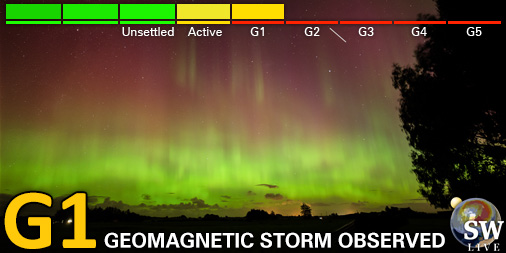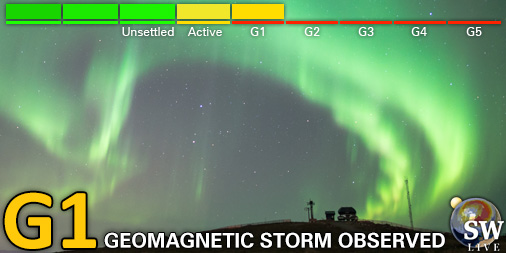Het archief bekijken van maandag 23 september 2024
Dagelijks bulletin over zonne- en geomagnetische activiteit van het SIDC
Datum verslag: 2024 Sep 23 1231 UTC
SIDC Prognose
Zonnevlammen
M-class flares expected (probability >=50%)
Geomagnetisme
Quiet (A<20 and K<4)
Proton Flux monitor
Quiet
| 10cm flux | Ap | |
|---|---|---|
| 23 Sep 2024 | 163 | 007 |
| 24 Sep 2024 | 163 | 007 |
| 25 Sep 2024 | 163 | 032 |
Zonnevlekkengebieden en zonnevlammen
Solar flaring activity over the past 24 hours was moderate. There are seven numbered regions on the visible solar disc with NOAA ARs 3828 (beta-gamma), 3831 (beta) and 3835 (beta) being the most active in the last 24 hours. NOAA AR 3835 produced the strongest flare of the day, an M3.7 flare with peak at 21:39 UTC on 22 September. The solar flaring activity is likely to remain at moderate over the coming days, with more M-class flares possible.
Coronale massa uitstoten
A partial halo CME with apparent angular width around 180 degrees erupted on 22 September at 21:37 UTC (first seen by LASCO C2), with a speed of around 1300 km/s. It is directed to the southeast but it has an Earth component that could hit the Earth around 6:00 UTC on 25 September, according to EUHFORIA.
Coronale gaten
A small equatorial positive polarity coronal hole crossed the central meridian on 21 September. A mild high speed stream may arrive at Earth on 25 September.
Zonnewind
Over the past 24 hours the solar wind parameters (ACE and DSCOVR) were indicative of a slow solar wind regime. The interplanetary magnetic field was below 9 nT with a minimum Bz of -6 nT. The solar wind velocity decreased to about 380 km/s. Similar slow wind conditions are expected to continue for the next 24 hours.
Geomagnetisme
The geomagnetic conditions over the past 24 hours were quiet both globally and locally (Kp and K_Bel from 0 to 2). Similar conditions are expected for the next 24 hours.
Proton flux niveaus
Over the past 24 hours the greater than 10 MeV GOES proton flux has been at nominal levels and is expected to remain so over the next 24 hours.
Elektronenfluxen in geostationaire baan
The greater than 2 MeV electron flux as measured by GOES 16 and GOES 18 has been slightly above the 1000 pfu threshold on 22 September. It is expected to be below threshold over the next 24 hours. The 24h electron fluence was at normal levels and is expected to remain so over the next 24 hours.
Het geschatte internationale zonnevlekkengetal (ISN) van vandaag: 134, gebaseerd op 13 stations.
Zon indexen voor 22 Sep 2024
| Wolfgetal Catania | /// |
| 10cm zonneflux | 163 |
| AK Chambon La Forêt | 011 |
| AK Wingst | 005 |
| Geschatte Ap | 004 |
| Geschat internationaal zonnevlekkengetal | 143 - Gebaseerd op 11 stations |
Overzicht opvallende gebeurtenissen
| Dag | Start | Max | Einde | Locatie | Sterkte | OP | 10cm | Catania/NOAA | Soorten radio-uitbarstingen |
|---|---|---|---|---|---|---|---|---|---|
| 22 | 2112 | 2139 | 2205 | S20E63 | M3.7 | 2N | --/3835 | III/2VI/2 |
Aangeboden door het Solar Influences Data Analysis Center© - SIDC - Verwerkt door SpaceWeatherLive
Alle tijden in UTC
<< Keer terug naar de dagelijkse overview pagina
Op basis van de huidige parameters is er in de nabije toekomst een beperkte kans op poollicht op de volgende locaties van de hoge breedtegraad
Gillam, MB, Yellowknife, NTLaatste nieuws
Laatste forumberichten
Steun Poollicht.be!
Om ook bereikbaar te blijven bij grote poollichtkansen hebben we een zware server nodig die alle bezoekers aankan. Doneer en steun dit project zodat we online blijven en je geen enkele poollichtkans mist!

Laatste alerts
zondag 6 april 2025
02:00 UTC - Geomagnetische activiteit
G1 - Kleine geomagnetische storm (Kp5) Drempel bereikt: 01:50 UTC
zaterdag 5 april 2025
20:30 UTC - Geomagnetische activiteit
G1 - Kleine geomagnetische storm (Kp5) Drempel bereikt: 20:20 UTC
20:24 UTC - Zonnevlam
Matige M1.05 zonnevlam
20:09 UTC - Radio blackout
Kleine R1 radio blackout gedetecteerd (≥M1 - momenteel: M1.05)
10:00 UTC - Hemisferisch vermogen
Het OVATION-model voorspelt dat het hemisferisch vermogen 78GW zal bereiken om 10:32 UTC
Ruimteweer feitjes
| Laatste X-klasse uitbarsting | 28/03/2025 | X1.1 |
| Laatste M-klasse uitbarsting | 05/04/2025 | M1.0 |
| Laatste geomagnetische storm | 06/04/2025 | Kp5 (G1) |
| Zonnevlekkenloze dagen | |
|---|---|
| Laatste zonnevlekkenloze dag | 08/06/2022 |
| Maandelijks gemiddeld zonnevlekkengetal | |
|---|---|
| maart 2025 | 134.2 -20.4 |
| april 2025 | 150.4 +16.2 |
| Afgelopen 30 dagen | 132.4 -10.1 |





